British scientists develop autism brain scan
British scientists have developed a 15-minute brain scan they hope could be used to detect autism in children, cutting both the time and cost of diagnosing the disorder. Researchers from the Institute of Psychiatry at King's College London have...

British scientists have developed a 15-minute brain scan they hope could be used to detect autism in children, cutting both the time and cost of diagnosing the disorder.
Researchers from the Institute of Psychiatry at King's College London have published details of the technique, which has been tested on adults and shown to have 90 percent accuracy in detecting autism.
Children are presently assessed through a lengthy process that tests social interaction, communication and imaginative skills.
A confirmed diagnosis is rare before 18 months, and most often occurs much later.
Christine Ecker, a member of the institute's research team, said the new tool's benefits could be "immense".
"It could help to alleviate the need for the emotional, time-consuming and expensive diagnosis process which ASD (autism spectrum disorder) patients and families currently have to endure," she said.
"We now look forward to testing if our methods can also help children."
The British scientists hope the new method will be both quicker and up to 20 times more cost effective.
The scans cost between 100 pounds (160 dollars, 120 euros) and 200 pounds, far cheaper than current alternatives in Britain.
The technique assesses structural changes in the brain. It is expected to take more than two years before it is ready to be rolled out for general use.
Autism and related disorders affect up to six or seven out of every 1,000 individuals.
Symptoms are lifelong and can vary widely, but often include impaired social skills, repetitive behaviours, difficulty in expressing one's emotions, and an aversion to physical intimacy. There is no known cure.
The new technique developed by the Institute of Psychiatry researchers involves taking pictures of the brain with a magnetic resonance imaging scanner.
The scans are reconstructed into 3D images and analysed by computer software programmed to spot hallmarks of autism in the structure of different brain areas.
The results of testing the technique on 20 adults with autism and the same number of healthy "control" volunteers were published in The Journal of Neuroscience".
All those taking part were men aged between 20 and 68. After first being asked to undergo the conventional diagnostic procedure, each participant had his brain scanned. The outcomes of both techniques were then compared.
The brain scan method was 90 percent accurate in correctly identifying the autistic patients. It also showed a negative result for healthy controls in 80 percent of cases.